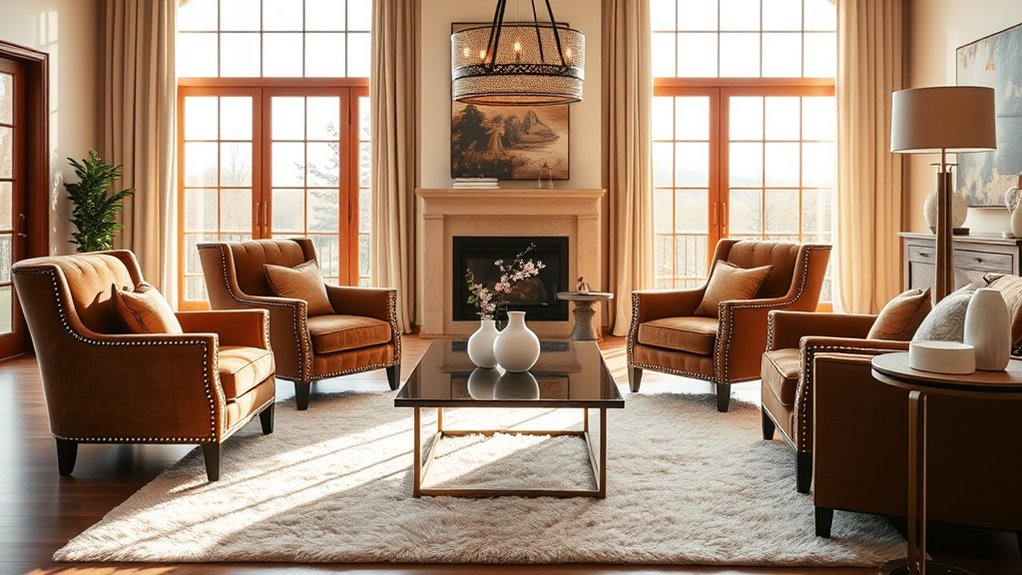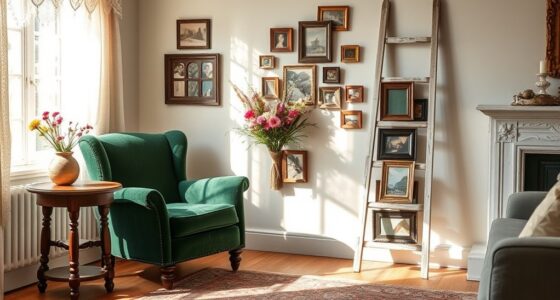Know when to splurge and when to save in your home design by focusing on key areas like quality furniture, luxury materials, or statement pieces that have a big visual or functional impact. Save on smaller accessories, decor, and DIY projects that add personality without breaking the bank. Prioritize investing in items that last, and use budget-friendly options for accents. Keep exploring to discover more expert strategies for creating a stylish, balanced space.
Key Takeaways
- Splurge on durable, high-quality materials like luxury countertops or statement furniture that impact longevity and overall aesthetic.
- Save on accessories, decor, and DIY projects that personalize spaces without compromising style or function.
- Prioritize spending on items that combine comfort and durability, such as sofas or mattresses, to maximize value.
- Use budget-friendly options or DIY solutions for small details and finishing touches to enhance character cost-effectively.
- Invest wisely by researching product reviews and energy efficiency to ensure long-term savings and quality.

Creating a beautiful home doesn’t have to break the bank. When planning your design, it’s essential to know when to splurge and when to save. One way to elevate your space without overspending is by investing in luxury materials for key areas. High-end finishes, like marble countertops or hardwood flooring, can transform a room and add a sense of sophistication. These materials may seem costly upfront, but they often last longer and require less maintenance, making them a smart investment. When you’re focused on creating a striking focal point—say, a statement wall or a centerpiece piece—spending a bit more on quality can make all the difference. This approach ensures that your home feels luxurious without the need to overhaul every detail.
At the same time, you can economize by tackling DIY projects. Not only do DIY projects give you a chance to personalize your space, but they also cut down on labor costs. Painting walls, installing light fixtures, or refurbishing furniture are tasks you can learn to do with a little research and patience. These projects allow you to incorporate unique touches and custom elements that reflect your style, all while keeping costs down. Plus, completing DIY projects can be incredibly satisfying, giving your home a sense of authenticity and personality that store-bought items sometimes lack. When choosing which aspects to DIY, focus on areas that don’t require specialized skills or expensive tools. For example, creating decorative wall art or assembling simple furniture can be rewarding and budget-friendly. Additionally, selecting farmhouse textiles and accessories like rustic dish towels or vintage-inspired decor can enhance your space’s charm affordably.
Knowing where to splurge and where to save involves strategic planning. Spend more on items that contribute considerably to your home’s overall aesthetic and longevity, such as luxury materials or statement furniture pieces. Save on accessories, decor, or smaller furnishings by opting for budget-friendly options or DIY solutions. For instance, instead of buying a costly chandelier, you might find a stylish, affordable pendant light or even craft your own. It’s also wise to prioritize spending on items that add comfort and functionality, like a quality sofa or a durable mattress, over purely decorative objects. Considering product reviews can help you make informed decisions about quality and value before making a purchase. Additionally, being aware of the power consumption of heated mattress pads can help you manage energy costs effectively. Moreover, understanding personality traits can assist you in creating a home environment that truly reflects your lifestyle and preferences. Incorporating sound design principles can also help create a more relaxing and inviting atmosphere in your space.
Ultimately, balancing these choices requires foresight and creativity. Use your budget wisely by investing in quality where it counts and personalizing your space through DIY projects. This approach ensures your home looks stunning, feels cozy, and stays within your means. Remember, a well-designed home isn’t about how much you spend but about making smart choices that reflect your style and meet your needs.
Frequently Asked Questions
How Do I Determine My Overall Home Design Budget?
You determine your overall home design budget by starting with a clear budget estimation. Break down your spending categories, like furniture, renovations, and decor, to see where your money should go. Consider your income and prioritize essential areas first. Track your expenses to stay within limits. This approach helps you balance your spending, ensuring you get the design you want without overspending.
What Are the Best Sources for Affordable yet Stylish Home Décor?
You’ll find great affordable yet stylish home décor by exploring DIY projects and thrift shopping. DIY projects let you customize pieces to match your style without spending much, while thrift stores and flea markets offer unique, budget-friendly finds. Keep an eye out for vintage items and repurpose furniture to add character. Combining these approaches helps you create a beautiful home without overspending, making your space truly personalized and cost-effective.
How Can I Prioritize Spending on Different Rooms?
You should prioritize spending based on each room’s focal points and functionality. Invest more in spaces where you spend the most time or entertain guests, like the living room or kitchen, to create a strong visual impact. For other rooms, focus on essentials and cost-effective décor. This approach helps balance your budget while enhancing the overall feel of your home, ensuring each room serves its purpose beautifully.
When Should I Hire a Professional Versus DIY?
Imagine tackling a project so complex that DIY pitfalls could turn your dream home into a nightmare! When your skills, time, or tools fall short, it’s time to call in professional expertise. Save yourself from costly mistakes and stress by hiring experts for electrical work, plumbing, or major renovations. For simple updates or cosmetic changes, DIY can be fun and budget-friendly. Know your limits, and choose wisely!
How Do I Balance Quality and Cost in Furniture Choices?
Balancing quality and cost in furniture choices involves prioritizing material durability for long-lasting pieces. You should invest in high-quality items for frequently used furniture, ensuring style consistency throughout your home. For less visible or infrequently used pieces, opt for budget-friendly options that still match your aesthetic. This way, you get durability and style without overspending, creating a cohesive look that’s both functional and cost-effective.
Conclusion
Remember, striking the right balance between splurging and saving is like walking a tightrope—you want to enjoy the view without falling. Prioritize your must-haves and invest wisely in quality pieces that will stand the test of time. Be strategic with your budget, and your dream home will come to life without breaking the bank. With a little planning, you’ll turn your space into a masterpiece that’s both beautiful and budget-friendly.









